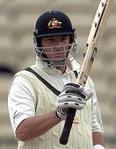I find captivating those athletes who commentators often blithely describe as ‘making it look easy’.
Two in particular held a particular fascination: Darren Jarman (below left, Aussie Rules footballer) and Mark Waugh (below right, cricketer).

It was more than them making the game look easy; it was how they made the others around them look that resonated with me. These other guys had spent their entire careers striving to become among the best in the world at their sport, and reach the same level as Jarman and Waugh – and yet for fleeting moments they were reduced to near-spectators – barely participants – as Waugh or Jarman took their level of play to unassailable levels.
Of course, the Waughs and Jarmans of the world could not sustain this unassailable level for any length of time; in fact, it was that these periods of brilliant nonchalance were far outweighed by much longer periods of pedestrian, maddening play whereby they made the easy or routine seem difficult, or where they seemed to care little about what was happening around them.
(What was also interesting about Waugh and Jarman was that both had a brother (in Mark’s case, a twin) who not only reached the same level but extracted more out of their potential than their sibling, or who were much more workmanlike in their play.)
For Jarman and Waugh, this sense of being anti-workmanlike – particularly as it was shown in sharp relief against their brother’s style of play – was to me compelling. I would have rather watched Mark bat for 5 minutes than Stephen for 100.
Now, there have been those athletes who have managed to merge seeming effortless with fully realising their potential, with this combining to make fellow competitors look second-rate: tennis player Roger Federer and sprinter Usain Bolt are two.
But these Federer/Bolt types are less appealing to me than the ‘almost’ types such as Waugh or Jarman. I think it’s because it’s the sense of ‘us’ in them; if we were suddenly to become enriched with sporting ability and chose to apply it in cricket or football, then our best would resemble Waugh and Jarman at their best. Conversely, because their less-than-good can appear very bad indeed, it reminds us that they are, indeed, just like us: capable of doing dumb things at dumb times. They represent both our aspirations and our reality.
Let us dissect one such moment of grotesque Jarman skill in a bid to shine further light on the topic (from the 3:13 to 3:30 mark, apologies if the clip below doesn’t load in this spot):
In the 1997 AFL Grand Final, Jarman (#3) kicked five goals in the final quarter to seal the Adelaide Crows’ first premiership. From the video, you can see the skill utilised to kick one of those five goals with his non-preferred foot once he obtains possession. But the part I find mesmerising occurs before he gets the ball: at the moment the ball is punched towards them both, Jarman’s teammate Kane Johnson (28) is closer to the ball, and by the time it lands the ball would be equidistant from them had they stayed still.
But something occurs while the ball is in the air: by the time it has landed and Jarman grabs it, he is metres in the clear.
Now Johnson was a fine AFL player, who no-one would doubt would be faster than Jarman over 20 metres, 50 metres or 100 metres and who had the required skill and ability to sustain a long, productive career. But over 5 metres, when something outside of the ordinary is required, Jarman tantalisingly unleashes the sheer mental computational power – and consequent physical output – for a split second of very difficult made to look very easy.
In a split second, Jarman has processed what’s happened, what’s about to happen, and has taken two or three steps towards where the ball lands before Johnson has even taken a step. By the time Johnson processes the same information, Jarman has the ball and has kicked it; Johnson concedes by not following the path of the ball and begins to run toward the goal instead.
In perhaps the best basketball non-fiction piece I’ve read, Sports Illustrated’s Rick Telander visits New York in the heat of summer in the mid 1990s to reacquaint himself with the city’s street basketball scene he’d previously covered some 20 years in an also brilliant book, Heaven Is A Playground.
Telander finishes the piece describing its hero, Booger Smith, in an apt and fitting description of the nonchalant brilliance of the few:
The remarkable thing about many of Booger’s moves is that he cannot replicate them off the court. They are unplanned, unpracticeable responses to stimuli.
Now Booger does something unbelievable … [it] does not seem possible without the cooperation of the opponent. But these guys want to bury Booger. They are not accomplices.
I doubt whether Jarman could have replicated that goal – an unplanned, unpracticeable response to a stimulus – in a controlled, sterile, laboratory-like environment. And that he couldn’t, I find kind of magical.